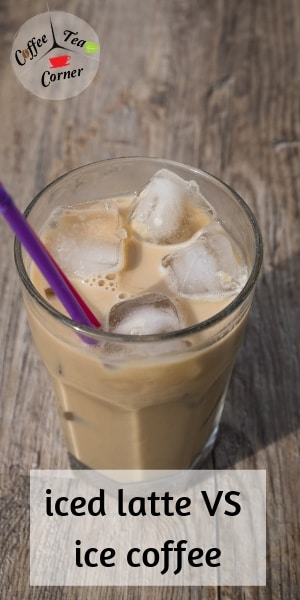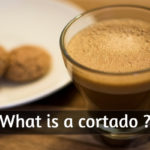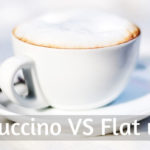Looking for the difference between iced latte and iced coffee ? They're both great drinks, but there are some key differences between them. And those might prove to be just what you like or dislike about them.
So let's go on and see what the main differences between iced coffee and latte are, and which would be your favorite.
Table of Contents
So what's the difference between iced coffee and iced latte ?
While both drinks are coffee-based, and require ice, an iced latte has a large amount of chilled milk added to it. The iced coffee on the other hand can be either black coffee, or milk coffee but with a very small amount of milk. Over ice, of course.
So the main difference between the two is the milk content, actually the coffee to milk ratio.
There are many variations and tweaks on the two coffees, and in a way you could argue that iced latte is just a variation of iced coffee. And you'd be right. It's just that the different names help distinguish between the coffee types in terms of temperature, milk, flavors, and sometimes sizes.
Let's talk about each of these two drinks though, so you can get a better grip on both kinds of coffee.
If you want to make the best coffee at home, you absolutely need to check my article on the best coffee gear.
Iced coffee has little to no milk added
Iced coffee is actually the main coffee out of which any other iced coffee drink is based on. The whole point of the iced coffee is to provide the nutrients and caffeine kick of a cup of coffee, but in a cold brew.
It's a welcome treat on hot summer days, or in hot humid places. Most of the time iced coffee is brewed hot, as a long shot of espresso (called a lungo), and then chilled and poured over ice.
You can add milk if you like, though there isn't room for lots usually. And if you'd like it sweetened, it's best to ask for the sugar before your coffee is poured over ice to help the sugar melt.
Another form of iced coffee - depends on where you're ordering form - is filter coffee, but over ice. This allows for more brewed liquid, and it tastes different than a long espresso. It also won't have the crema that an espresso usually does.
Finally, you can also make iced coffee with cold brewed coffee. This is actually the proper way to make iced coffee, but you won't find it as the norm in many coffee shops or even homes. We'll touch on that in a bit.
Iced latte has a small amount of coffee
Iced lattes are made up of coffee - either an espresso or a stronger form of filter coffee - with chilled milk poured over it, and served in a glass full of ice.
This means that your latte will not be a strong-tasting coffee, and it will contain more milk than coffee. This is actually what sets it apart from the iced coffee, aside from the proper brewing process.
While iced coffee can contain a bit of milk if you want, it's nowhere near as much as it is in a latte. As a sort of ratio, a latte has a 1:8 coffee to milk ratio, so it's actually more of a coffee-flavored milk drink than the other way around.
Lattes are found sweetened more often than iced coffee. This can be due to the milk or creamer used, since some places or people choose to use condensed milk instead of fresh milk, like the Vietnamese for example.
There is a sort of middle ground, but that varies from coffee shop to coffee shop and sometimes even the names of drinks themselves are made up.
A real middle ground, in terms of milk content, would be a cappuccino. But that's hard to make iced, since hot milk foam won't sit well on top of an iced drink. So you'd have to froth milk with a tiny whisk/mixer, which won't be nearly as good as steamed milk.
Brewing the coffee for cold serving the right way
The best way to brew coffee to serve it over ice is to brew it cold, actually. I'll explain how to do this in a bit.
It seems to be the best way to brew coffee for a drink that's meant to be served cold since you won't be losing flavor and aroma through the evaporation of the hot coffee.
The problem with preparing coffee hot, and then cooling it is that you're losing the flavor, and storing it in the fridge won't help either. It'll keep the coffee cold, but the flavor will be largely gone.
It won't lose caffeine, so that's not something that you should worry about. It's just the taste that's going to be different.
So back to cold brewing coffee for iced coffee or iced latte, you're going to need warm water. That's going to be as much water as you need, but heated to about 32 C/90 F, and add double the amount of coffee grounds you'd normally add for a regular coffee.
Your coffee will bloom and the grounds will expand a bit, and then you can cover the pot with a secure, airtight lid.I recommend finding a good glass container with a safe lid.
Once your coffee mixture is in place, you're going to have to let it sit for about 8 hours. If you leave it for 10 it will still be alright.
Once it's done brewing you can transfer it into whatever container you need it to be, and be sure to strain it beforehand. Even if you think you're very careful with keeping the coffee grounds behind in the pot, no one likes bits of coffee in their drink.
This is not a very common way to prepare coffee, even if it's meant to be for an iced coffee or latte simply because it takes so long to brew. An espresso or filter coffee is much faster and thus easier on the barista when asked for an iced drink.
The taste differences between a hot coffee that has been chilled, and a cold brewed coffee are noticeable once you know both ways of brewing the coffee. But for the most part, it's not the worst way to make iced coffee.
How to make iced coffee and iced latte
Alright, now that you know about hot brewed coffee, and how to cold brew your coffee, you should feel free to choose which method you'd like to use for your next iced coffee drink.
If you're feeling very specific and would like to get the full experience, I recommend you cold brew as much coffee as you would need. If you want a quick drink, then an espresso or filter coffee will do just as well.
The difference between an espresso and a filter will be in terms of how strong you like your coffee.
For example if you're aiming for an iced latte, the coffee would taste stronger if you used a shot of espresso rather than half a cup of filter coffee. Simply because espresso is so much stronger than filter coffee.
If you'd like to go for a lighter iced coffee, with just a bit of milk, then a whole cup of filter coffee, chilled and then poured over ice, will do just fine.
Once you've decided how much coffee you want and which type of iced drink you're going to make, you will need:
- a tall glass
- your preferred coffee, brewed whichever way you like
- milk, if you want it
- sugar, if you want it make sure to add when the coffee is warm
- a whole lot of ice
In the tall glass, add the ice. Add as much as you like. Though many places fill the glass almost all the way up with ice, this will kind of rob you of the coffee itself. It works very well if you're using espresso which is a smaller drink.
For iced coffee:
Over the ice pour your coffee. If you're going after iced coffee, stop there. You're done. You've got iced coffee right now, actual coffee over ice. You can leave it black like that, or add some milk if you want. It helps if the milk is very cold as well.
If you want to sweeten your coffee, make sure you do so when the coffee is still warm otherwise the sugar will just end up at the bottom of your glass.
With cold brewed coffee this won't really be possible, since there is no point where the coffee is warm enough. And adding sugar to the brew to let it sit overnight will not be a good idea for your final product.
For iced latte:
After you've added the ice, add your shot of coffee and the cold milk and stir together. If you'd like to sweeten the latte you can do so by using half milk, and half sweetened creamer.
Or, you can warm the milk, mix in as much sugar as you'd like, and then leave it to cool in the fridge for a few minutes. After that you can pour it over the drink.
This is the same thing as with the iced coffee. Sugar needs to be mixed in when the drink is warm, otherwise it will not melt well.
(If you like this article so far, you can pin it to your Pinterest board by clicking the image below. The article continues after the image.)
You can always tweak the recipe
There are ways to make this recipe yours, since there is no real recipe for iced latte or iced coffee, aside from the recommended brewing method.
For example one thing that some people can find annoying is how the drink gets watered down when the ice starts to melt. You can bypass this in two ways.
First is to do what many people do, and get yourself a much stronger coffee to pour over the ice. That is the usual and traditional method.
Another way is to use coffee cubes instead if ice cubes. All this means is that when you've brewed your coffee, let it cool for a bit (just so it's not steaming anymore) and then fill up an ice cube tray.
It might sound odd, but you're going to surprise yourself with how good of a hack this is. If you're in the beginning of summer, and you know you're an iced coffee/latte fan, then it might be wise to stock up on 2-3 coffee cube trays and keep restocking them as needed.
Of course, this means the actual coffee you brew for the iced coffee and iced latte won't have to be as strong since the coffee cubes won't water the drink down.
Other ways of tweaking and adjusting the recipe can include sweetening your drink with a syrup, rather than just sugar. You will need to look for a very liquid syrup, so not one that is very thick or is mostly used for toppings.
A few examples can include a chocolate syrup, caramel, strawberry, anything you like in your coffee, really. I for one am a big strawberry and caramel syrup fan, so that's what I get in my iced lattes sometimes.
If you'd like half milk and half coffee, then probably filter coffee is your best bet. Simply make filter coffee as usual, add in the sugar if you like, and the milk as well and pour over ice.
Is there more caffeine in iced coffee than in iced latte ?
This depends on what kind of coffee you're using for your drink. As in, what kid of coffee brew you're using for your drink.
If you're sticking with the optimal way to brew coffee for this kind of drink, then it will be very hard to calculate how much caffeine in is your drink, because cold brewing works slower on caffeine.
Also because one person will make their cold brewed coffee stronger, while another will make it lighter. If you're doing it with the same amount as with filter coffee, skip a few lines to the filter coffee part.
What I can tell you though, is that for a normal espresso (25 ml/ 0.84 oz) there's about 120-170 mg/0.004 - 0.006 oz of caffeine.
So if you're using a single shot of espresso for your drink, that's the amount of caffeine you'd get. We're going to use this as a comparison for everything else.
If you make your filter coffee like I do mine, you're adding 2 heaping teaspoons of ground coffee to about 266/9 oz of water and you're left with 8 oz/226 ml of actual coffee brew.
That's about the same caffeine content as a regular shot of espresso, possibly a bit higher because the filter kept the water in contact with the coffee for longer.
And when it comes to measuring out how much coffee you put in an iced latte or iced coffee, that depends what you're comparing.
If you're adding a shot of espresso in a medium sized glass full of ice, with a bit of milk added, then you've got as much caffeine as an espresso.
If you're adding half a cup of filter coffee to the same medium glass for iced coffee, you're going to half about half the caffeine of an espresso. Remember, that's usually 120-170 mg of caffeine (0.004 - 0.006 oz of caffeine for non-metric folk).
If you're adding a shot of espresso both to the latte and to the iced coffee, the caffeine content will be the same.
Finally, if you're using an Arabica blend then your coffee will have less caffeine than if you were using a Robusta coffee bean. Robusta beans have double the caffeine of Arabica, but they're much more bitter and less sweet.
For example a shot of espresso made of Robusta has more caffeine than one made of Arabica, even if espresso is a strong coffee brew.
So it really comes down to how much coffee is in your drink, how it's prepared, and what kind of coffee beans were ground for your drink.
Even if you add the same amount of coffee grounds to 2 different coffee machines, the one that keeps the hot water in contact with the coffee will extract the most caffeine.
Like the drip-filter, the French press, and even the Vietnamese coffee.
Final thoughts
Iced coffee and iced latte can be two very delicious coffee drinks. They both share the same root - cold coffee over ice - but from there they diverge into two very different drinks.
I for one lean towards a latte, simply because I enjoy the taste of coffee but when it's meant as a treat (the way I see iced drinks) it has to be sweeter and more palatable than just cold coffee over ice.
As always you can go very far with this and end up with a frappe, or a coffee milkshake, and it would still contain coffee and thus caffeine as well.
So in the end you do what you like, and brew your coffee the way you like it. While the best and most recommended method of brewing coffee for a cold drink is to cold-brew it, not everyone has the time to prepare the coffee beforehand.
If you want to know more about coffee or tea, feel free to check the related articles below. Who knows what else you might find ?






